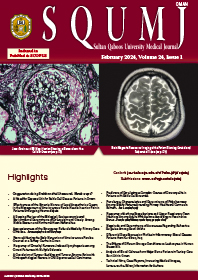Main Article Content
Abstract
Objectives: This study aimed to determine the prevalence, characteristics and determinants of polypharmacy among elderly patients in Bahrain. Methods: This cross-sectional study was conducted between March and April 2022 in all primary healthcare centres in Bahrain. A simple random sample was obtained. An elderly patient was defined as one aged ≥60 years and polypharmacy was defined as the concomitant use of 5 or more medications, with excessive polypharmacy defined as the concomitant use of 10 or more medications. Results: A total of 977 patients were included, with more than half of them being females (n = 533, 54.55%) and the mean age of the participants at 67.90 ± 6.87 years. Essential hypertension, hyperlipidaemia and diabetes mellitus were the most common comorbidities among the participants (61.51%, 57.63% and 53.22%, respectively). Among the cohort, 443 (45.34%) were on 5 or more medications and of those 66 (6.76%) were on at least 10 medications. A multivariate analysis revealed that patients with diabetes (odds ratio [OR] = 5.836, 95% confidence interval [CI]: 4.061–8.385; P <0.001), hypertension (OR = 6.231, 95% CI: 4.235–9.168; P <0.001), hyperlipidaemia (OR = 3.999, 95% CI: 2.756–5.802; P <0.001), cardiovascular diseases (OR = 3.589, 95% CI: 1.787–7.205; P <0.001) and asthma (OR = 3.148, 95% CI: 1.646–6.019; P <0.001) were significantly more likely to suffer from polypharmacy. Conclusion: Polypharmacy is prevalent among elderly patients in Bahrain, particularly among those with non-communicable diseases. Polypharmacy should be considered while delivering healthcare services to the elderly, especially those with non-communicable diseases.
Keywords: Aged; Elderly; Polypharmacy; Bahrain.
Article Details

This work is licensed under a Creative Commons Attribution-NoDerivatives 4.0 International License.
